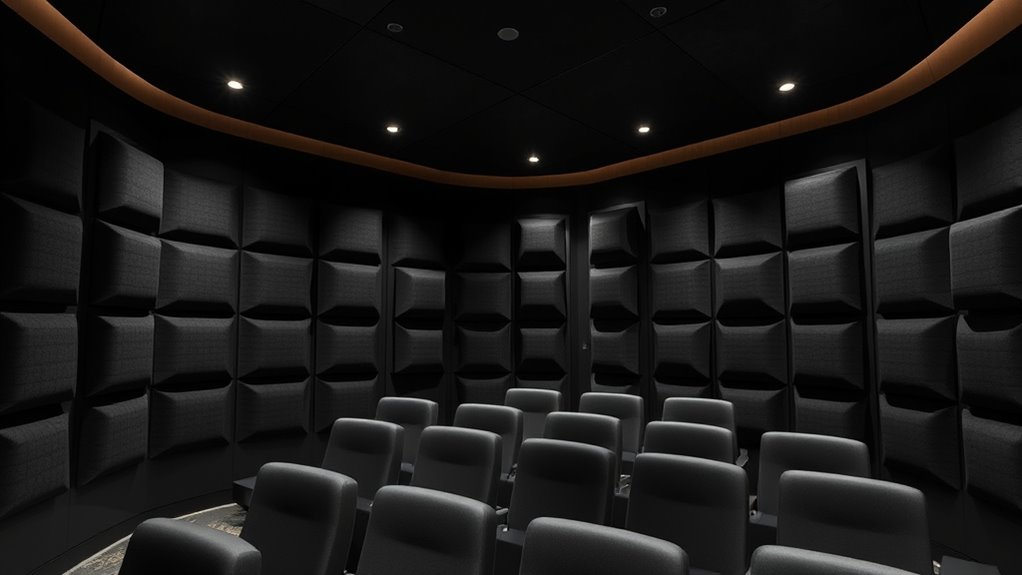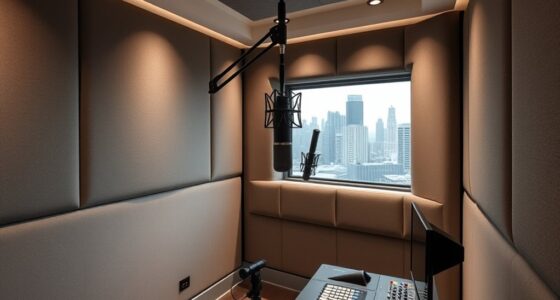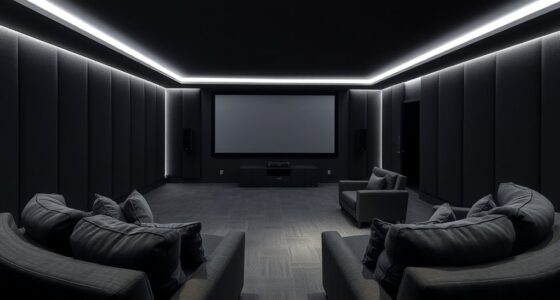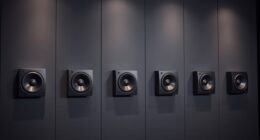To improve sound quality in your projector room, start by adding acoustic panels on walls and ceilings at reflection points to absorb echoes and reduce reverberation. Incorporate bass traps in corners to control low frequencies and diffuse sound evenly with diffusers. Soft furnishings like curtains, rugs, and upholstered furniture complement these treatments. Proper speaker placement and sealing noise leaks also help. Keep exploring for more tips to create an acoustically balanced space that enhances your viewing experience.
Key Takeaways
- Place acoustic panels at reflection points on walls and ceiling to reduce echo and improve sound clarity.
- Use bass traps in corners to control low-frequency reverberations and prevent sound muddiness.
- Incorporate diffusers to scatter sound evenly and avoid dead spots or flutter echoes.
- Combine soft furnishings like rugs and curtains with panels to balance sound absorption across frequencies.
- Seal gaps around doors and windows and consider soundproofing materials for external noise reduction.

If you’ve ever struggled with unwanted echo or muffled sound in a room, acoustic panels and treatments can make a substantial difference. In a projector room, clarity is vital for both viewing and audio quality. Soundproofing techniques and thoughtful room acoustic design are essential to achieve the best sound environment. Soundproofing helps prevent noise from leaking in or out, while acoustic treatments focus on managing sound reflections within the space. When you combine these strategies, you create an environment where sound is clear, balanced, and free from distracting echoes.
Acoustic panels and soundproofing create clear, balanced audio in projector rooms.
Start by evaluating your space’s unique acoustics. Identify areas where sound waves bounce excessively, creating reverberations that muddy the audio. Acoustic panels are a practical solution here. They absorb sound energy, reducing echo and improving speech intelligibility. Installing panels on walls and ceilings, especially at reflection points, can greatly enhance sound quality. For a projector room, it’s important to choose panels with the right absorption coefficient to target frequencies that cause echo. Acoustic treatments aren’t just about foam panels; consider bass traps in corners and diffusers that scatter sound evenly, preventing dead spots and flutter echoes.
Room acoustic design involves more than just adding panels. It requires a strategic approach to placement and room layout. For example, positioning speakers and seating to optimize sound pathways ensures viewers experience clear audio without distortion. Avoid hard, reflective surfaces near sound sources or seating areas, as these can amplify unwanted reflections. Using rugs, curtains, or upholstered furniture can complement acoustic panels by absorbing sound at different frequencies, creating a balanced acoustic environment. Additionally, selecting high-quality projectors with accurate sound reproduction can further improve overall audio clarity.
Incorporating soundproofing techniques can further elevate your projector room’s performance. Sealing gaps around doors and windows prevents outside noise from intruding, while adding mass-loaded vinyl or soundproof drywall can block sound transmission through walls. These measures are especially important if your space is in a noisy environment or shared with other activities. Combining soundproofing with room acoustic design ensures that you’re controlling both external noise and internal reflections, resulting in a space perfect for viewing and listening.
Ultimately, improving your projector room’s sound quality involves a combination of effective acoustic panels and strategic soundproofing. By paying attention to room acoustic design, you tailor the environment to your needs, making every movie or presentation an immersive experience. With these techniques, your space transforms into a well-balanced acoustic sanctuary where sound clarity isn’t compromised by unwanted echoes or external noise.
Frequently Asked Questions
How Do Acoustic Panels Affect Room Temperature and Ventilation?
Acoustic panels mainly improve sound absorption, so they don’t substantially impact room temperature. However, they can affect ventilation slightly by reducing airflow if placed improperly or densely packed. You might notice minor changes in ventilation impact, but overall, acoustic panels are designed to optimize sound quality without compromising temperature or airflow. Just ensure proper placement to maintain good ventilation while enhancing sound absorption effectively.
Are There Eco-Friendly Acoustic Treatment Options Available?
Yes, eco-friendly acoustic treatments are available, turning your space into a sanctuary of sustainability. You can choose panels made from recycled materials, like repurposed wood or plastic, which breathe new life into waste. Organic fabrics also provide natural sound absorption without harmful chemicals. By selecting these options, you create a healthier environment, where sound and nature harmonize, showcasing your commitment to both quality and the planet’s well-being.
How Often Should Acoustic Panels Be Replaced or Maintained?
You should replace or maintain acoustic panels based on their panel durability and your maintenance schedule. Typically, inspect them every 1-2 years for signs of wear, damage, or accumulated dirt. If panels show significant deterioration or lose effectiveness, it’s time for replacement. Regular maintenance, including cleaning and checking for damage, helps prolong their lifespan and guarantees ideal sound quality in your projector room.
Can DIY Acoustic Treatments Match Professional Results?
You can achieve DIY effectiveness that rivals professional quality if you carefully select materials and follow proven techniques. While DIY acoustic treatments may not match the precision of professional setups, they can markedly improve sound quality when properly installed. Focus on proper placement, insulation, and acoustic panel design, and you’ll find that your DIY efforts can come quite close to professional results, saving you money without sacrificing too much performance.
What Is the Ideal Placement for Acoustic Panels in a Projector Room?
Did you know that proper acoustic panel placement can reduce echo by up to 50%? You should position panels at first reflection points on walls and ceiling, where sound bounces. Focus on acoustic positioning by placing panels behind and to the sides of your projector screen, as well as in corners for bass control. This setup guarantees balanced sound, enhances clarity, and creates an immersive viewing experience.
Conclusion
By adding acoustic panels and treatments, you create a quiet sanctuary where sound waves gently dance around your projector room. Imagine the panels as silent guardians, perfectly positioned like cushions on a sofa, absorbing unwanted echoes. As you sit back and enjoy your movies, the room feels like a cozy theater, with crystal-clear sound wrapping you in a perfect embrace. It’s no coincidence—these treatments transform your space into a haven of pristine audio, just as you envisioned.









